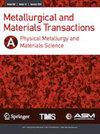Effect of Solution Heat-Treatment on the Oxidation Resistance of Ni-Base Single-Crystal Superalloy
IF 2.2
3区 材料科学
Q3 MATERIALS SCIENCE, MULTIDISCIPLINARY
Metallurgical and Materials Transactions A-Physical Metallurgy and Materials Science
Pub Date : 2023-10-02
DOI:10.1007/s11661-023-07205-7
引用次数: 0
Abstract
Abstract To clarify the effect of solution heat-treatment on the oxidation resistance of Ni-base single-crystal superalloy TMS-238, the evaluation of dendrite/inter-dendrite segregation of alloying elements in the as-cast and heat-treated samples, and its effect on cyclic oxidation resistance were investigated. Cyclic oxidation test results at 1100 °C for up to 150 cycles clearly showed that the as-cast samples with element segregations had lower oxidation resistance compared to heat-treated samples with homogeneous structure. Further, for the as-cast sample, rapid growth and spallation of oxide consisting of NiO, Cr 2 O 3 , and Al 2 O 3 were observed around the dendrite core for 10 cycles of oxidation. Analysis of sub-surface on sample isothermally oxidized at 1100 °C for 10 minutes showed that rapid oxide growth is due to the formation of discontinuous Al 2 O 3 layer at dendrite core with lower Al concentration. Furthermore, in this study, the threshold value of Al concentration and Gibbs energy for the formation of continuous Al 2 O 3 layer were estimated and determined to be around 5.2 wt pct and − 556.6 ± 0.5 kJ/mol, respectively. This indicated that the solution heat-treatment for TMS-238 should be conducted above 1305 °C for exhibiting oxidation resistance at 1100 °C, to meet the threshold value within the whole region between dendrite and inter-dendrite.

固溶热处理对镍基单晶高温合金抗氧化性能的影响
摘要:为了研究固溶热处理对镍基单晶高温合金TMS-238抗氧化性能的影响,研究了铸态和热处理试样中合金元素枝晶/枝晶间偏析的影响及其对循环抗氧化性能的影响。在1100℃下循环氧化150次的结果清楚地表明,与具有均匀组织的热处理样品相比,具有元素偏析的铸态样品具有较低的抗氧化性。此外,铸态样品在10个循环的氧化过程中,在枝晶核心周围观察到由NiO、cr2o3和al2o3组成的氧化物的快速生长和剥落。对1100℃等温氧化10分钟试样的亚表面分析表明,由于Al浓度较低,在枝晶核心处形成不连续的al2o3层,导致了氧化物的快速生长。此外,在本研究中,估计并确定了形成连续Al 2o3层的Al浓度和吉布斯能的阈值分别约为5.2 wt pct和- 556.6±0.5 kJ/mol。这表明TMS-238要在1100℃时表现出抗氧化性,需要在1305℃以上进行固溶热处理,以满足枝晶与枝晶间整个区域的阈值。
本文章由计算机程序翻译,如有差异,请以英文原文为准。
求助全文
约1分钟内获得全文
求助全文
来源期刊
CiteScore
5.30
自引率
7.10%
发文量
322
审稿时长
6 months
期刊介绍:
Metallurgical and Materials Transactions A focuses on the latest research in all aspects of physical metallurgy and materials science. It explores relationships among processing, structure, and properties of materials; publishes critically reviewed, original research of archival significance.
The journal address the main topics of alloy phases; transformations; transport phenomena; mechanical behavior; physical chemistry; environment; welding & joining; surface treatment; electronic, magnetic & optical material; solidification; materials processing; composite materials; biomaterials; and light metals. MMTA publishes Technical Publications, Communications, Symposia, and more.
Published with ASM International, The Materials Information Society and The Minerals, Metals & Materials Society (TMS)

 求助内容:
求助内容: 应助结果提醒方式:
应助结果提醒方式:


